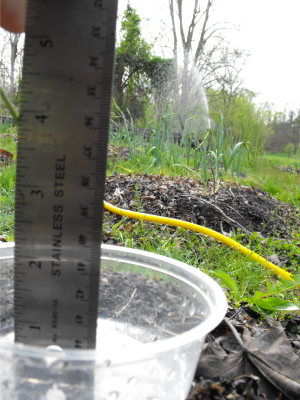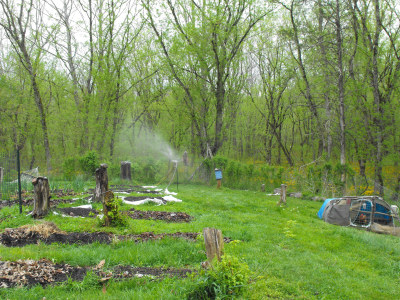
How to ensure even sprinkler coverage
 Most
fruits and vegetables require one inch of water per week during the
growing season.
Sprinklers are a great backup to natural rainfall, but how long do you
turn them on to get that precious inch? How do you know if your
garden is being evenly watered?
Most
fruits and vegetables require one inch of water per week during the
growing season.
Sprinklers are a great backup to natural rainfall, but how long do you
turn them on to get that precious inch? How do you know if your
garden is being evenly watered?
Last year, I learned
that it's best to
situate your sprinklers so they provide head
to head coverage,
but that trick isn't enough to ensure even watering with an irregularly
shaped garden. Instead, you'll need to put your sprinklers where
you think they should go, then run
some irrigation tests. Scatter empty containers every few yards
across the garden, blast the sprinklers for an hour, then go back and
measure the amount of water in each container.
To help you visualize
wet and dry spots, draw a rough map of the garden and write in the
water depth at each container location. Do a bit of math to
figure out the average water depth across the garden, then circle areas
which ended up with less than average water.
Now it's time to move
the sprinklers a bit to make those dry spots go away. If you're
lucky, you will have noticed an abnormally wet spot on one side of a
sprinkler and an abnormally dry spot on the other side. In this
case, you can simply move the sprinkler a few feet closer to the dry
spot and away from the wet spot.
 On
the other hand, you may simply have too few sprinklers in play.
If there are dry spots at the outer limits of two sprinklers, you may
need to add a third sprinkler to fill in the gaps.
On
the other hand, you may simply have too few sprinklers in play.
If there are dry spots at the outer limits of two sprinklers, you may
need to add a third sprinkler to fill in the gaps.
Once you move the
sprinklers, run another irrigation test and repeat the process until
your garden is getting the same amount of water in every
container. I chose to stop tweaking the sprinklers once the
containers were all within the same ballpark --- how obsessive you get
about this is up to you.
It will take a few hours
of your time to get the sprinklers set up properly, but the irrigation
tests are well worth the work. Now your garden will be evenly
hydrated, and you will even know how long it takes to provide that
critical inch of water. Due to different sprinkler orientations,
I figure I need to run each set of sprinklers for three hours to get an
inch of water in the upper garden and for two hours to get an inch in
the mule garden. I guess it only took three and a half inches of
water to saturate that hydrophobic
compost --- not
nearly as bad as I thought.
Want more in-depth information? Browse through our books.
Or explore more posts by date or by subject.
About us: Anna Hess and Mark Hamilton spent over a decade living self-sufficiently in the mountains of Virginia before moving north to start over from scratch in the foothills of Ohio. They've experimented with permaculture, no-till gardening, trailersteading, home-based microbusinesses and much more, writing about their adventures in both blogs and books.
Want to be notified when new comments are posted on this page? Click on the RSS button after you add a comment to subscribe to the comment feed, or simply check the box beside "email replies to me" while writing your comment.
